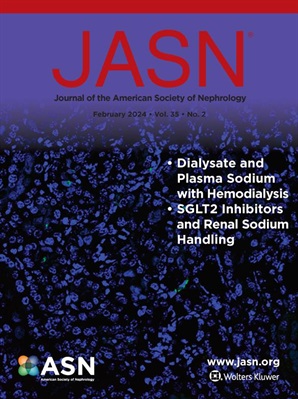使用eGFR斜率阈值作为肾脏疾病进展分层复合终点的终点成分。
IF 10.3
1区 医学
Q1 UROLOGY & NEPHROLOGY
引用次数: 0
摘要
研究人员开发并验证了一种肾脏疾病进展分层复合终点(HCE),该终点结合了时间到事件的终点和估计肾小球滤过率(eGFR)下降率(eGFR斜率)作为连续终点。这种连续终点的替代方案是在绝对和相对尺度上应用各种阈值,用于eGFR斜率分量的两两比较。我们评估了不同阈值对治疗效果的影响,以及对肾脏疾病进展HCE的统计能力,使用赢率进行分析。方法:我们计算了7项国际3期CKD试验的获胜几率,并比较了不同eGFR阈值(0.5、0.75或1.0 mL/min/1.73m2/年eGFR斜率差异)的原始HCE与HCE的治疗效果,以及分类阈值和由eGFR斜率差异百分比确定的阈值。此外,我们使用自举抽样程序估计了这些阈值的统计能力,以评估它们对审判效率的影响。结果:在7项CKD试验中,无论采用哪种eGFR阈值,获胜几率估计都保持一致,并且统计能力略有下降。例如,对于阈值0(原始HCE)、0.5、0.75和1.0,DAPA-CKD试验的获胜几率为1.41 (95% CI;1.32, 1.52), 1.41 (95% ci;1.31, 1.51), 1.40 (95% ci;1.31, 1.51)和1.40 (95% CI;1.30, 1.50),在500个样本量下,统计能力分别为97%、92%、92%和93%。结论:我们的研究结果表明,在肾脏疾病进展HCE中使用eGFR阈值不会改变治疗效果的估计,与持续使用相比,对统计能力的影响很小。本文章由计算机程序翻译,如有差异,请以英文原文为准。
Use of eGFR Slope Thresholds as End Point Components in a Kidney Disease Progression Hierarchical Composite End Point.
BACKGROUND
We developed and validated a kidney disease progression hierarchical composite end point (HCE) combining time-to-event end points with the rate of estimated glomerular filtration rate (eGFR) decline (eGFR slope) as a continuous end point. An alternative to this continuous end point is to apply various thresholds on an absolute and relative scale for the pairwise comparisons in the eGFR slope component. We assessed the impact of different thresholds on the treatment effects and statistical power on the kidney disease progression HCE analyzed using win odds.
METHODS
We calculated the win odds in seven international phase 3 CKD trials and compared treatment effects for the original HCE versus HCEs with different eGFR thresholds (0.5, 0.75, or 1.0 mL/min/1.73m2/year eGFR slope difference), as well as categorical thresholds and thresholds determined by percent differences in eGFR slope. In addition, we estimated the statistical power for these thresholds using a bootstrap sampling procedure to evaluate their impact on trial efficiency.
RESULTS
For the seven CKD trials, the win odds estimate remained consistent, combined with a minor reduction in statistical power regardless of which eGFR thresholds were applied. For instance, for thresholds 0 (original HCE), 0.5, 0.75, and 1.0 the win odds of the DAPA-CKD trial were 1.41 (95% CI; 1.32, 1.52), 1.41 (95% CI; 1.31, 1.51), 1.40 (95% CI; 1.31, 1.51) and 1.40 (95% CI; 1.30, 1.50) with 97%, 92%, 92%, and 93% statistical power for a sample size of 500, respectively.
CONCLUSIONS
Our findings suggest that using eGFR thresholds in the kidney disease progression HCE did not alter treatment effect estimates and had only a minimal effect on statistical power compared to its continuous use.
求助全文
通过发布文献求助,成功后即可免费获取论文全文。
去求助
来源期刊
CiteScore
22.40
自引率
2.90%
发文量
492
审稿时长
3-8 weeks
期刊介绍:
The Journal of the American Society of Nephrology (JASN) stands as the preeminent kidney journal globally, offering an exceptional synthesis of cutting-edge basic research, clinical epidemiology, meta-analysis, and relevant editorial content. Representing a comprehensive resource, JASN encompasses clinical research, editorials distilling key findings, perspectives, and timely reviews.
Editorials are skillfully crafted to elucidate the essential insights of the parent article, while JASN actively encourages the submission of Letters to the Editor discussing recently published articles. The reviews featured in JASN are consistently erudite and comprehensive, providing thorough coverage of respective fields. Since its inception in July 1990, JASN has been a monthly publication.
JASN publishes original research reports and editorial content across a spectrum of basic and clinical science relevant to the broad discipline of nephrology. Topics covered include renal cell biology, developmental biology of the kidney, genetics of kidney disease, cell and transport physiology, hemodynamics and vascular regulation, mechanisms of blood pressure regulation, renal immunology, kidney pathology, pathophysiology of kidney diseases, nephrolithiasis, clinical nephrology (including dialysis and transplantation), and hypertension. Furthermore, articles addressing healthcare policy and care delivery issues relevant to nephrology are warmly welcomed.

 求助内容:
求助内容: 应助结果提醒方式:
应助结果提醒方式:


